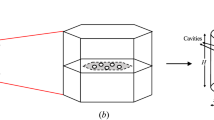Abstract
Enhancing the strength and thermal conductivity of A319 aluminium alloy powertrain components can reduce instances of premature failure, by resisting or alleviating thermal stresses that develop during engine operation. These properties can be manipulated theoretically through microstructural control, for example via variation of the alloy solidification rate. Although increasing solidification rate has been observed to achieve improved mechanical properties, its influence on thermal conductivity is yet unclear. In this study, A319 alloy was cast with a succession of solidification rates by using a permanent mould preheated to a range of temperatures. The as-cast samples were comprehensively characterized in terms of their dendritic structures, secondary phase morphologies and area fractions, porosity, ultimate tensile strengths and Rockwell hardness values, and thermal conductivities, the latter of which was measured via the transient plane source method. The results demonstrated that refinement and other changes in microstructure with increasing solidification rate promoted no noticeable variation in thermal conductivity, despite improvements to strength and hardness. Thus, solidification rate can be controlled effectively to design the mechanical properties of A319 components without detriment to its thermal properties.











Similar content being viewed by others
References
Callister W (2010) Materials science and engineering: an Introduction, 8th edn. Wiley, New York
Lumley R, Deeva N, Larsen R, Gembarovic J, Freeman J (2013) The role of alloy composition and T7 heat treatment in enhancing thermal conductivity of aluminum high pressure diecastings. Metall Mater Trans A 44A:1074–1086
Stadler F, Antrekowitsch H, Fragner W, Kaufmann H, Pinatel E, Uggowitzer P (2013) The effect of main alloying elements on the physical properties of Al–Si foundry alloys. Mater Sci Eng A 560:481–491
Mulazimoglu M, Drew R, Gruzleski J (1989) The electrical conductivity of cast Al–Si alloys in the range 2 to 12.6 wt pct silicon. Metall Trans A 20A:383–389
Vandersluis E, Lombardi A, Ravindran C, Bois-Brochu A, Chiesa F, MacKay R (2015) Factors influencing thermal conductivity and mechanical properties in 319 Al alloy cylinder heads. Mater Sci Eng A 648:401–411
Vázquez-López C, Calderón A, Rodriguez M, Velasco E, Cano S, Colás R, Valtierra S (2000) Influence of dendrite arm spacing on thermal conductivity of an aluminum-silicon casting alloy. J Mater Res 15(1):85–91
Argo D, Drew R, Gruzleski J (1987) A simple electrical conductivity technique for measurement of modification and dendrite arm spacing in Al–Si alloys. AFS Trans 95:455–464
Narayan Prabhu K, Ravishankar B (2003) Effect of modification melt treatment on casting/chill interfacial heat transfer and electrical conductivity of Al–13% Si alloy. Mater Sci Eng A 360:293–298
Manzano Ramirez A, Espinoza Beltran F, Yanez-Limon J, Vorobiev Y, Gonzalez-Hernandez J (1999) Effects of porosity on the thermal properties of a 380-aluminum alloy. J Mater Res 14(10):3901–3906
Vandersluis E, Ravindran C (2018) Estimating the effective metal-mould interfacial heat transfer coefficient via experimental-simulated cooling curve convergence. Trans Indian Inst Met 71(5):1231–1236
Vandersluis E, Ravindran C (2018) Relationships between solidification parameters in A319 aluminum alloy. J Mater Eng Perform 27(3):1109–1121
Vandersluis E, Ravindran C (2017) Comparison of measurement methods for secondary dendrite arm spacing. Metallogr Microstruct Anal 6:89–94
Davis J (1993) ASM specialty handbook: aluminum and aluminum alloys. ASM International, Materials Park
ASTM B557 (2014) Standard test methods for tension testing wrought and cast aluminum. ASTM International, West Conshohocken
Gustafsson S (1991) Transient plane source techniques for thermal conductivity and thermal diffusivity measurements of solid materials. Rev Sci Instrum 62(3):797–804
Log T, Gustafsson S (1995) Transient plane source (TPS) technique for measuring thermal transport properties of building materials. Fire Mater 19(1):43–49
Samuel F, Ouellet P, Samuel A, Doty H (1998) Effect of Mg and Sr additions on the formation of intermetallics in Al-6 wt pct Si-3.5 wt pct Cu-(0.45) to (0.8) wt pct Fe 319-type alloys. Metall Mater Trans A 29(12):2871–2884
Lombardi A, D’Elia F, Ravindran C, MacKay R (2014) Replication of engine block cylinder bridge microstructure and mechanical properties with lab scale 319 Al alloy billet castings. Mater Charact 87:125–137
Narayanan L, Samuel F, Gruzleski J (1994) Crystallization behavior of iron-containing intermetallic compounds in 319 aluminum alloy. Metall Mater Trans A 25:1761–1773
Hegde S, Prabhu K (2008) Modification of eutectic silicon in Al–Si alloys. J Mater Sci 43:3009–3027. https://doi.org/10.1007/s10853-008-2505-5
Hwang J, Doty H, Kaufman M (2008) The effects of Mn additions on the microstructure and mechanical properties of Al–Si–Cu casting alloys. Mater Sci Eng A 488:496–504
Acknowledgements
The authors are thankful to the Natural Sciences and Engineering Research Council of Canada (NSERC) for the award of the Canada Graduate Scholarship to Eli Vandersluis and for financial support of this project. The authors are grateful to Alan Machin, Payam Emadi, Dr. Anthony Lombardi, and the members of the Centre for Near-Net-Shape Processing of Materials (CNPM) at Ryerson University for experimental assistance and support. Further, the authors would like to thank Thomas Warren of Gamma Foundries Inc. for the chemical analysis of samples.
Author information
Authors and Affiliations
Corresponding author
Ethics declarations
Conflict of interest
The authors declare that they have no conflict of interest.
Data availability
Additional raw/processed data required to reproduce these findings cannot be shared at this time, as the data also form part of an ongoing study.
Rights and permissions
About this article
Cite this article
Vandersluis, E., Ravindran, C. Influence of solidification rate on the microstructure, mechanical properties, and thermal conductivity of cast A319 Al alloy. J Mater Sci 54, 4325–4339 (2019). https://doi.org/10.1007/s10853-018-3109-3
Received:
Accepted:
Published:
Issue Date:
DOI: https://doi.org/10.1007/s10853-018-3109-3




